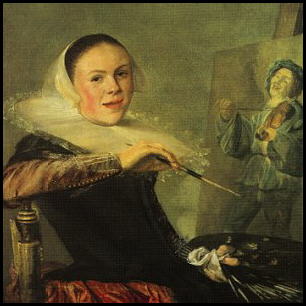
| Judith Leyster (1609-1660) was one of the most outstanding Dutch genre
painters of her era. She is best known for her joyful scenes with people
from everyday life, especially musicians, but she also painted portraits
and still lifes.
Unlike most other female artists of her time, Leyster was not born into an artistic family. It is likely that she was forced to find a way to support herself in her teens when her father, who was a weaver and brewery owner, declared bankruptcy. When she was in her mid-twenties, Leyster became the only female member of the Haarlem painters' guild and created her Self-Portrait about 1635, as a presentation piece to the guild. One of her most original images is the genre scene known as The Proposition or Man Offering Money to a Young Woman, where the woman’s point of view becomes obvious. Male artists used to depict this type of scene with seductively clad women who are clearly enjoying their treatment. Leyster on the other hand reveals the vulnerability of the unmarried women, who obviously disdains the coins she is being offered. Leyster was extremely successful in her day, receiving commissions for portraits and genre pieces. She is also known to have had three male students, which means she had a good reputation. Most of her works were painted between 1633 and 1636, the year of her marriage with another Haarlem painter. The couple moved to Amsterdam, where she resided for the rest of her life. She bore at least three children, and after that she had no longer time to pursue her artistic activity. When she died she was unknown. Over time, her work was attributed to several famous male artists. In the 1890s, her signature – the intials JL joined together with a star, punning the meaning of her last name "leading star" – was found on a painting formerly attributed to Frans Hals. From that time her fame has slowly regained and she is now regarded as an influential 17th century Dutch artist.
|